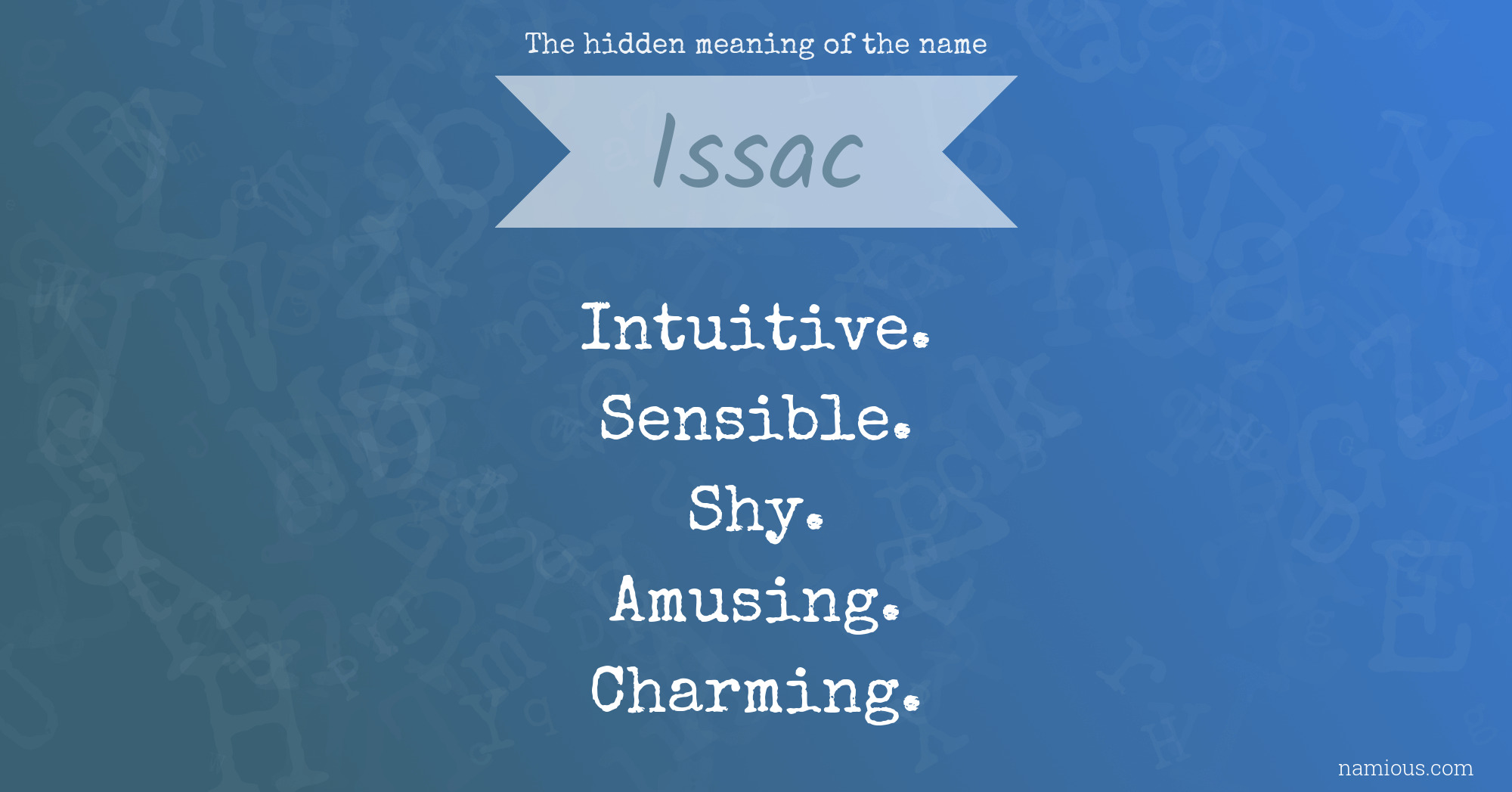Unpacking The Story Of Issac: Insights From Genesis 22 And Beyond
Have you ever stopped to think about stories that really stick with you, the ones that seem to hold deep truths no matter how many times you hear them? There are, you know, some tales that just resonate through the ages, sparking conversations and new ways of looking at life. One such story, really quite a powerful one, centers around a figure known as Issac. It's a narrative that has shaped a great many beliefs and ideas for countless generations, and it's still talked about a lot even today.
The particular account we are talking about, as a matter of fact, comes from Genesis 22. This part of the Bible, so it's known, is pretty remarkable. It has a long and rich history of discussion and thought within both Jewish and Christian traditions. People have spent centuries trying to grasp its full meaning, and that's just a little bit of what makes it so special.
In Hebrew, this specific story is called the Akedah, which is a shorter way of saying "the binding of Issac." The way the story is told, the Hebrew writing itself, which was already very well done in earlier parts of Genesis, arguably reaches its absolute peak here. It's a model of being concise and economical with words, telling a huge story with very few extra bits, which is quite something.
Table of Contents
- Who Was Issac?
- The Akedah: A Deep Look at Genesis 22
- Unraveling Ancient Practices and Archaeology
- Issac's Legacy and Enduring Interpretations
- Questions People Often Ask About Issac
- Reflecting on Issac's Story Today
Who Was Issac?
Issac, as a figure, is pretty central to some really old stories. He's often thought of as one of the patriarchs, a foundational father figure, in the Abrahamic faiths. His life, in a way, is a bridge between the stories of his father, Abraham, and his own sons, Jacob and Esau, so he's a very important link in that chain.
His birth, for example, is presented as a miraculous event, coming to his parents, Abraham and Sarah, when they were quite old. This detail, you know, really emphasizes a sense of divine promise and blessing associated with him from the very start. His name, Issac, actually means "he laughs," which is a nod to his mother Sarah's reaction when she first heard she would have a child at her age.
Here are some basic details about Issac, the biblical figure:
| Name | Issac |
| Parents | Abraham and Sarah |
| Spouse | Rebekah |
| Children | Jacob and Esau |
| Key Biblical Event | The Akedah (Binding) |
It's worth noting, too, that while the primary focus of the name "Issac" in the text refers to this biblical figure, the text also mentions "Joseph (Oscar Issac)" in a completely different context, referring to a local young man in a more modern depiction. Our discussion here, however, is very much about the ancient Issac of Genesis, as that's what the provided text mainly explores.
The Akedah: A Deep Look at Genesis 22
The Akedah, or the "binding of Issac," is arguably the most famous story involving Issac. It's a moment where Abraham is asked to offer his son, Issac, as a sacrifice. This request, naturally, tests Abraham's faith in an almost unimaginable way. The narrative is presented with such concision, so it is, that every word seems to carry immense weight.
Biblical scholars, as a matter of fact, have spent countless hours poring over this chapter. They've looked at it from many different angles, trying to grasp the deep meanings behind Abraham's obedience and Issac's role. The text itself, you know, doesn't waste any words, which makes the drama of the situation even more intense. It's really a masterclass in storytelling, capturing raw emotion and profound spiritual questions in very few lines.
One of the big questions that scholars often ask about this story is about the practice of sacrifice itself. Was it common for sons and daughters, especially those who were older, as opposed to infants, to be sacrificed in ancient times? This query, to be honest, opens up a whole field of discussion about the historical context and what this story might be saying about such practices. It's a rather complex topic, really, and scholars have different ideas.
The story, you see, often prompts us to think about the nature of faith, trust, and divine command. It's not just a historical record; it's a narrative that invites deep personal reflection. People, quite frankly, find themselves asking what they would do in such a situation, and that's part of its lasting appeal. It pushes you to consider very big ideas about belief and commitment.
Unraveling Ancient Practices and Archaeology
When we look at stories like the Akedah, we often wonder about the real-world backdrop. Is there any archaeological evidence, for instance, that helps us understand the practices mentioned in ancient texts? This question, you know, is something archaeologists and biblical scholars work on together. They try to find clues in the ground that might shed light on these very old accounts.
A special collection of Bible Review articles, for example, brings together biblical scholars who offer different avenues to understanding the Genesis account of the patriarch Abraham. These writings, arguably, show how much thought goes into trying to piece together the past. They look at the text from many angles, including what we know about ancient life and customs.
The Negev desert, for instance, was a region of great importance in ancient Israel, Judah, and the wider Levant. It has a rich history related to agriculture, mining, and trade. Knowing about the geography and daily life in these areas, you see, can sometimes help us understand the settings of biblical stories a bit better. It provides a kind of physical stage for these narratives.
Interestingly, sometimes archaeological finds can raise new questions or even challenge older ideas. For example, mosaics reflecting the zodiac and other pagan imagery have been discovered in several ancient synagogues. This kind of discovery, naturally, shows us that the past was often more varied and complex than we might first imagine. It suggests that different ideas and symbols could exist side-by-side, which is pretty fascinating.
Understanding the context, you know, helps us appreciate the nuances of the Akedah story. It's not just about what happened, but also about what it meant to the people who first told and heard it. Scholars like Janet Howe Gaines, whose full article about Jezebel appeared in Bible Review, help us see how figures from the Bible were understood in their own time and how their stories have been retold through the ages. This kind of work, frankly, adds so much depth to our reading.
Issac's Legacy and Enduring Interpretations
The story of Issac, particularly the Akedah, has left a truly lasting mark on human thought and culture. It's a story that people return to again and again, finding new meanings and lessons. In some respects, it's a foundational narrative for understanding faith and the relationship between humans and the divine. Its deep impact, you see, is something you can trace through centuries of art, literature, and religious practice.
Jewish interpretation of the Akedah, for example, often highlights Issac's willingness to be bound, seeing it as an act of profound devotion. It's not just Abraham's faith that's tested, but Issac's own acceptance of his fate. This perspective, you know, adds another layer of meaning to the story, making Issac an active participant in a moment of great spiritual significance. It's a pretty powerful idea, that.
Christian interpretations, similarly to that, often view the Akedah as a foreshadowing of later events, particularly the sacrifice of Jesus. They see parallels between Abraham's willingness to offer his only son and God's offering of His own Son. This way of looking at the story, naturally, connects it to broader theological themes and gives it a deeper resonance within Christian belief. It's a very strong connection for many believers.
The story also raises questions about obedience and morality, which are still very much discussed today. How do we understand a divine command that seems to go against human ethics? These are big, challenging questions, and the Akedah, arguably, forces us to confront them head-on. It's a story that doesn't offer easy answers, but rather prompts deep reflection and discussion, which is actually a good thing.
The idea of a "test" of faith is central to Issac's story. It suggests that sometimes, the most profound spiritual growth comes from facing the most difficult challenges. This idea, you know, resonates with people from all walks of life, whether they are religious or not. It speaks to the human experience of struggle and perseverance, which is something we all face at some point, honestly.
Questions People Often Ask About Issac
People often have a lot of questions about Issac and the Akedah. Here are some common ones:
What is the meaning of the Akedah?
The Akedah, or "binding," is a central story in Genesis 22. It tells of Abraham's test of faith when he is asked to sacrifice his son, Issac. The meaning, you know, is widely debated, with interpretations focusing on themes like obedience, divine testing, the nature of sacrifice, and God's covenant with Abraham. It's a very rich story with many layers of meaning, so it's not just one thing.
What was Issac's role in the Akedah?
While Abraham is the main figure being tested, Issac's role is also quite significant. He is depicted as a willing participant, carrying the wood for the sacrifice and allowing himself to be bound. This willingness, naturally, is often interpreted as an act of deep faith and obedience on his part. He's not just a passive character, but someone who makes a choice, which is pretty powerful.
Is there archaeological evidence for the Akedah?
There isn't direct archaeological evidence for the specific event of the Akedah itself. However, archaeological findings do provide context for the ancient world, including details about ancient religious practices, the geography of the Negev desert, and the daily life of people in the Levant during biblical times. These findings, you know, help scholars understand the broader setting in which such stories were told. They give us a sense of the time and place, which is helpful.
Reflecting on Issac's Story Today
The story of Issac, particularly the Akedah, continues to captivate and challenge us even in our modern world. It's a narrative that, in a way, pushes us to think about our own beliefs and what we truly value. The questions it raises about faith, sacrifice, and trust are, you know, timeless and still very relevant to discussions happening right now, in this day and age.
Reading these ancient accounts, you see, can offer us new ways to consider our own lives and the choices we make. It encourages a deeper look at the things that matter most. We can learn more about our site and the various ways ancient stories still speak to us. This kind of exploration, frankly, is a pretty good way to gain some perspective on life's bigger puzzles.
Perhaps, just a little, the enduring power of Issac's story lies in its raw portrayal of human experience facing something extraordinary. It's about a father, a son, and a moment of ultimate decision. If you're interested in similar deep dives into other significant figures and events, you might want to check out our other articles on this page . It's a story that will likely continue to spark conversation and reflection for generations to come, which is truly amazing.

Hexo

Issac

The hidden meaning of the name Issac | Namious